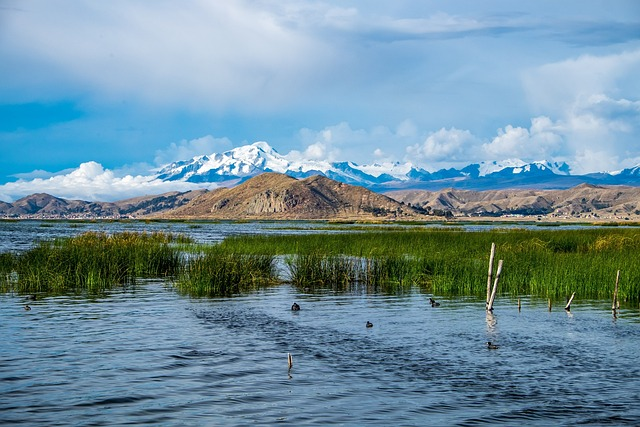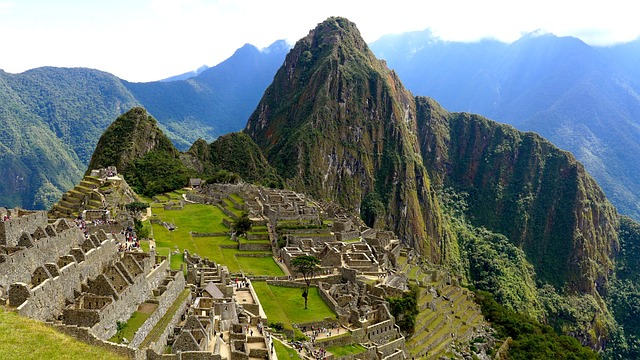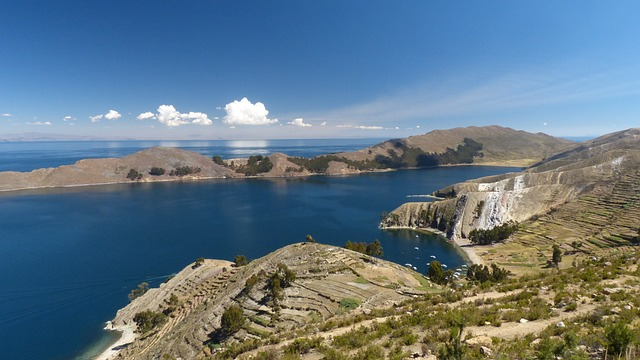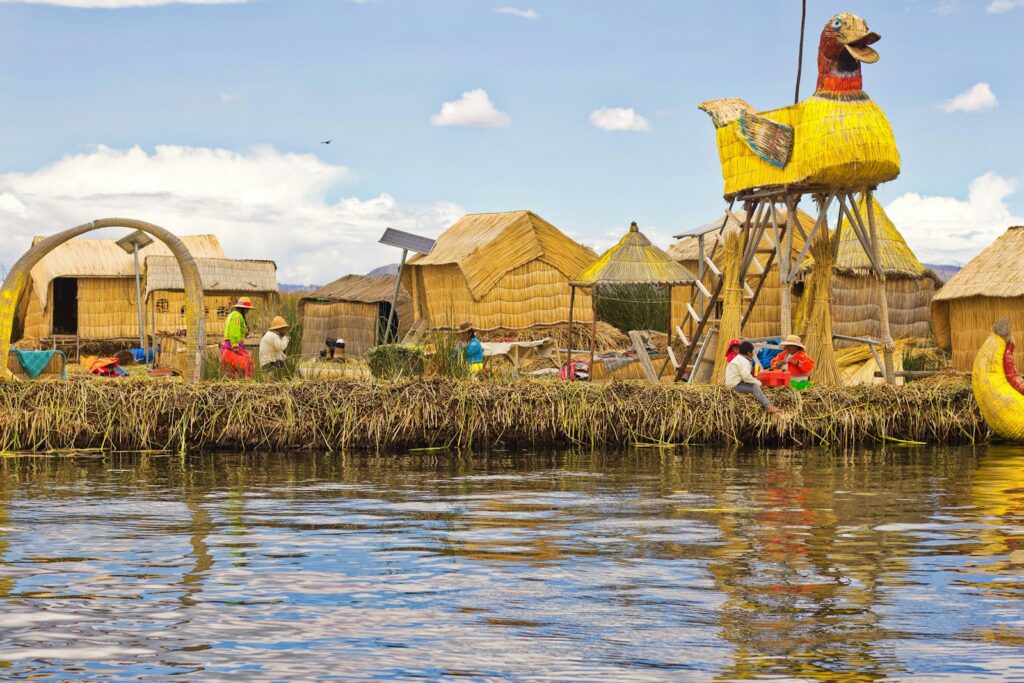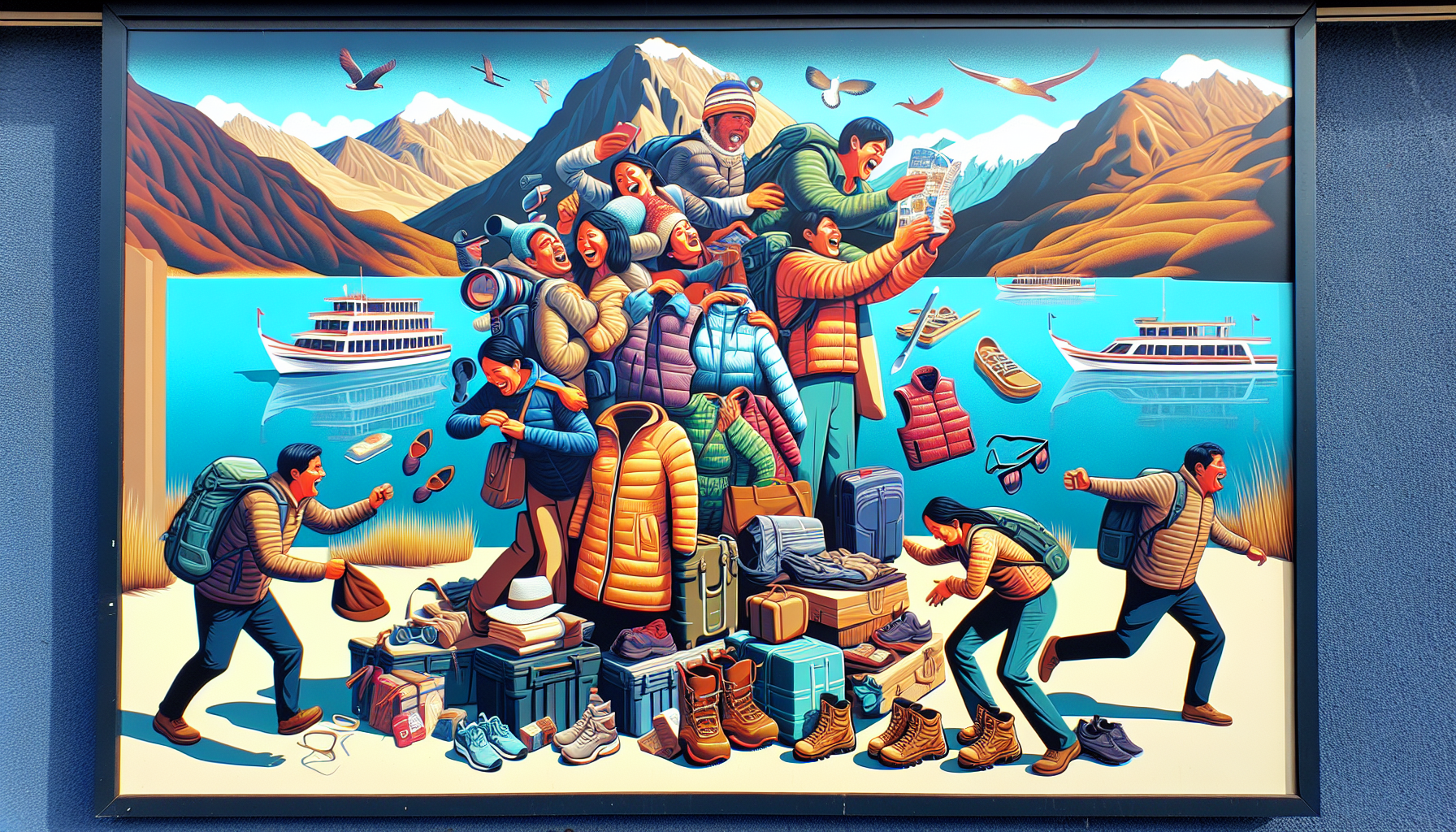- Home
- /
- Peru
- /
- Destinations
- /
- Exploring Lake Titicaca: Culture,...
Exploring Lake Titicaca: Culture, Nature, and Adventure Await
At 12,500 feet, Lake Titicaca isn’t just notable for its elevation—it’s a cradle of Andean culture and myth. From the Uros floating islands to the remnants of the Incas on Amantani and Taquile, your visit here is a dive into South America’s heart. This guide ensures you won’t miss any of the lake’s marvels, with practical tips to enhance your exploration.
Key Takeaways
- Lake Titicaca, located high in the Andes mountains at 12,500 feet, boasts distinct geographical features such as its vast area, considerable depth, and the Tiquina Strait, along with unique climate conditions due to its high-altitude setting.
- The lake is steeped in history and mythology, considered the birthplace of the Inca sun deity and civilization, with over 40 islands like Isla del Sol and Amantani offering immersive cultural and historical experiences.
- Visitors to Lake Titicaca can explore the renowned Uros floating islands, gain insights into the traditional lifestyles of the indigenous Uru people, and engage with the local culture and economy through tourism and handicrafts.
Discovering Lake Titicaca’s Geography and Climate
Perched high in the Andes at an elevation of 12,500 feet, Lake Titicaca rises as a shimmering jewel in the landscape. Here are some key facts about this magnificent lake:
- It covers an expansive area of approximately 3,200 square miles.
- It reaches up to 50 miles at its widest point, making it one of the largest lakes in South America.
- It is divided by the Tiquina Strait into two bodies.
- Its greatest recorded depth is a staggering 920 feet near Isla Soto.
The waters of Lake Titicaca have the following characteristics, which can be considered as lake averages, despite being situated at a high altitude far from sea level:
- Slightly brackish personality
- Average surface temperatures of 56 degrees Fahrenheit
- Seasonal fluctuations in water level, rising during the rainy season and receding in the dry winter months
- High-altitude weather patterns with pronounced wet and dry seasons and temperature variations throughout the year
Andean Ranges and High Plateau
Lake Titicaca nestles in a vast basin amidst the central Andes, with the striking Cordillera Real mountain range as its backdrop. The Cordillera Real, known for its snow-covered peaks, borders the lake on the northeastern Bolivian shore, adding to the lake’s dramatic beauty. The lake’s placement in the Andean ranges gives it a unique high plateau setting, making it a sight to behold. The lake’s northeast corner, in particular, offers stunning views of the Cordillera Real.
This geographical location and the high plateau setting give Lake Titicaca its unique weather patterns. The dry Altiplano conditions and the fierce Andean sun combine to create a unique climate that’s as captivating as it is challenging. As you navigate the hills and valleys around the lake, you’ll find that each twist and turn reveals a new aspect of the region’s raw and rugged beauty.
Lake Titicaca’s Waters
Lake Titicaca’s waters are a wonder in their own right. Sourced from five major river systems including the Ramis River, the waters of Lake Titicaca are largely fresh with only slight brackishness, making them a unique feature in this high altitude region. As Titicaca’s level fluctuates seasonally, the lake rises during the rainy season and recedes throughout the dry winter months. This change in water levels adds a dynamic element to the landscape, transforming the scenery with each passing season. The lake’s excess water during the rainy season contributes to these fluctuations.
The lake’s waters also hold a unique place in local folklore and history. According to Incan mythology, the waters of Lake Titicaca were the birthplace of the sun, adding a spiritual dimension to this geographic marvel. So, as you navigate the waters of Lake Titicaca, you’re not just exploring a lake, but also sailing through pages of ancient Incan lore.
Fierce Sun and Strong Winds
The Lake Titicaca region experiences intense sunlight that can cause high rates of evaporation. This fierce sun, combined with the strong reflection of sunlight off the lake, means that visitors must take extra precautions. It’s advisable to use sunblock, wear a wide-brim hat, and use sunglasses for protection.
In addition to the fierce sun, the region is also known for its strong winds. These winds sweep across Lake Titicaca, significantly affecting the local climate and shaping the daily lives of both locals and tourists. Whether you’re exploring the lake’s waters or hiking on its islands, be prepared for this dynamic element of Lake Titicaca’s climate.
Uncovering the Rich History and Inca Civilization
The waters of Lake Titicaca are not just geographical marvels—they’re also steeped in history and culture. According to Andean mythology, Lake Titicaca is considered the birthplace of the sun where the deity Viracocha created the sun, moon, stars, and first people. The lake is revered as the cradle of the Inca civilization, with legends stating that the origins of the first two Incas lie in its depths.
The children of the Sun god, Manco Cápac and Mama Ocllo, are said to have emerged from Lake Titicaca with a divine mandate to establish an empire that would honor the deity Inti. This spiritual significance is further underscored by the belief that Lake Titicaca is the soul’s final return destination in the Inca civilization.
Today, more than 40 islands dot Lake Titicaca, some of which serve as living museums of Inca culture, offering an unparalleled glimpse into this ancient civilization.
Isla del Sol
In the heart of Lake Titicaca lies the enchanting Isla del Sol. This island was incorporated into the Inca Empire in the mid-fifteenth century, enriching its religious importance. Today, the island is dotted with over 80 archaeological ruins that reflect its significance in the Inca civilization and mythology.
The island remains free from motorized traffic, preserving its ancient charm. Visitors traverse the landscape via a network of rocky trails leading to sacred sites. The island’s main village, Yumani, serves as the primary hub for tourist accommodations, while Cha’llapampa is renowned for its ruins and a gold museum. A visit to Isla del Sol offers a journey back in time, revealing the whispers of the ancient Inca civilization.
Amantani and Taquile Islands
While Isla del Sol is steeped in history and mythology, Lake Titicaca is also home to other islands that offer a unique cultural experience. Taquile Island and Amantani Island, for instance, are known for their traditional lifestyle, reflecting the rich heritage of the Peruvian side of Lake Titicaca. The inhabitants of Taquile Island are renowned for their skilled textile work, providing stunning views of the lake and serving as a cultural hallmark of the island.
Amantani, often referred to as the ‘Island of Love’, offers a romantic landscape that has become a favored destination for couples seeking less explored spots. Visitors spending two days on an island tour from Puno can expect simple yet comfortable accommodation while staying on Amantani Island.
Each island in Lake Titicaca has its own charm and unique story to tell, enriching your journey with a blend of history, culture, and natural beauty.
Experiencing the Floating Islands: Uros and Beyond
As you journey across Lake Titicaca, you’ll encounter a marvel that’s as unique as it is fascinating—the Uros floating islands. These islands are the most famous attraction on Lake Titicaca, offering a glimpse into a way of life that has remained unchanged for centuries. The indigenous Uru people inhabit these islands, maintaining a traditional lifestyle that includes hunting, fishing, and bird hunting.
Tourism is an integral part of the Uros community’s subsistence. When you visit the floating islands, you have the opportunity to:
- Purchase colorful handmade crafts, supporting the local economy
- Step onto a unique geographical feature
- Step into a living, breathing culture that has been nurtured by the lake’s waters for generations.
Life on the Floating Islands
The floating islands of Lake Titicaca, the world’s highest navigable lake, offer a unique lifestyle that’s as intriguing as it is inspiring. Home to the Uros people, these artificial islands are constructed using native totora reeds, with houses built from the same material. The islands are kept in place by anchoring them with poles driven into the lakebed to avoid drifting away.
The maintenance of each island is crucial. When properly cared for, an island can last up to 30 years, usually housing between two to three families. The Uros community not only constructs homes from totora reeds but also uses them for food, medicine, and as a source of fuel. Cultural life is vibrant among the Uros, with communal amenities such as a floating church for worship and floating schools for education.
Visiting the Uros islands offers a unique opportunity to experience a way of life that’s perfectly adapted to the lake’s unique conditions.
Boat Tours and Reed Crafts
Exploring Lake Titicaca and its floating islands isn’t complete without a boat tour. These tours are a popular way to explore the lake and experience its cultural heritage. A favored option among visitors is the half-day island tour that includes visits to Taquile Island and the floating Uros Islands.
As you navigate the waters of Lake Titicaca, you’ll also have the opportunity to witness the traditional reed craftsmanship of the region. Souvenir shopping often involves purchasing items made from the totora reeds, adding a touch of Lake Titicaca’s unique culture to your travel memories. Whether you’re exploring the lake’s waters or browsing through local crafts, every moment at Lake Titicaca adds a new layer to your travel experience.
Exploring the Shores: Puno and Copacabana
Your journey through Lake Titicaca isn’t limited to its waters and islands. The shores of the lake are home to vibrant cities that offer a blend of culture, history, and natural beauty. On the Peruvian side, the city of Puno is famous for its rich cultural heritage and serves as the folklore capital of Peru. From traditional music and dance performances to exploring pre-Inca ruins, Puno offers a plethora of experiences for visitors. Some highlights include:
- Traditional music and dance performances
- Exploring pre-Inca ruins
- Visiting the Puno Cathedral
- Taking a boat tour to the Uros Floating Islands
- Sampling local cuisine and traditional dishes
On the Bolivian shore, the picturesque town of Copacabana awaits. Known for its beautiful setting on Lake Titicaca’s shores, Copacabana holds a spiritual significance with the Basilica of Our Lady of Copacabana attracting pilgrims and tourists alike. Whether you’re exploring the historical sites of Puno or soaking in the natural beauty of Copacabana, the shores of Lake Titicaca offer experiences that complement your island adventures.
Puno, Peru
Puno, situated on the shores of Lake Titicaca, offers a rich tapestry of culture and history. The city is host to the La Candalaria Festival, a grand Catholic celebration in honor of the Virgin Mary, featuring lively street parades, music, dancing, and traditional costumes that take place during the first two weeks of February.
The city’s nearby attractions add to its appeal. Some of the attractions that visitors can explore include:
- The enigmatic Aramu Muru Doorway, accessible through a full-day excursion
- The pre-Incan Sillustani burial grounds that sit a short drive from the city
- The Temple of Fertility in Chucuito, noted for its numerous phallic figures
With a variety of hotel and restaurant options, Puno ensures a comfortable and enriching stay for all visitors.
Copacabana, Bolivia
On the Bolivian side of Lake Titicaca lies the charming town of Copacabana. This small town offers a unique charm with its picturesque off the beaten track ambiance and a vast array of activities available for visitors exploring Lake Titicaca. Its spiritual significance is highlighted by the Basilica of Our Lady of Copacabana, a major place of worship that features Stations of the Seven Sorrows of Mary, particularly revered during Holy Week.
Beyond its spiritual appeal, Copacabana is a gateway to outdoor adventures. Visitors can enjoy hiking, strolling along the beach, and partaking in traditional meals. The town also provides access to Isla del Sol, with its Incan ruins and beautiful panoramic lake views.
Whether you’re seeking spiritual solace, outdoor adventures, or cultural immersion, Copacabana offers a unique blend of experiences that add depth to your Lake Titicaca adventure.
Practical Tips for Planning Your Lake Titicaca Adventure
Now that you’re ready to embark on your Lake Titicaca adventure, it’s important to plan your journey well. Whether you’re starting your journey from major nearby cities such as Cusco and Arequipa or planning your accommodations on the Amantani islands, being prepared can help you make the most of your adventure.
Packing for a trip to Lake Titicaca requires some careful thought. Here are some tips to help you prepare:
- Keep hydrated at high altitudes
- Dress in layers for the varied temperatures
- Pack comfortable walking shoes
- Bring sunscreen and a hat for sun protection
- Don’t forget your camera to capture the stunning views
- Pack a reusable water bottle to reduce waste
- Bring a rain jacket or umbrella for unpredictable weather
- Don’t forget any necessary medications or personal items
Remember, careful planning and preparation are the keys to a memorable journey, especially when traveling in a northwest to southeast direction.
Getting There
Getting to Lake Titicaca is part of the adventure. The lake is accessible from major nearby cities such as Cusco and Arequipa. To reach Lake Titicaca from these cities, one can take a one-hour flight followed by a 40-minute taxi ride. This allows you to reach the lake quickly and comfortably, giving you more time to explore its many attractions.
Alternatively, for those who prefer a more scenic route, an 8-hour bus journey can bring travelers from Cusco or Arequipa to Lake Titicaca. This route offers stunning views of the Andean landscape, adding a touch of adventure to your journey. Whether you choose to fly or take the bus, the journey to Lake Titicaca is sure to be an unforgettable part of your adventure.
Where to Stay
Accommodation options around Lake Titicaca range from luxury lodges to authentic island stays. Luxurious accommodations such as Titilaka Lodge with its panoramic windows and private beach, and GHL Hotel Lago Titicaca boasting a private port and spectacular views, offer a comfortable and indulgent stay.
For a stay amidst ancient Incan history, Isla del Sol offers basic yet authentic accommodations that allow for an extended experience of the island’s offerings. With a variety of options to suit different preferences and budgets, you’re sure to find the perfect place to rest after a day of exploring the wonders of Lake Titicaca.
Packing Essentials
Packing for a trip to Lake Titicaca requires careful consideration of the region’s unique climate and terrain. Here are some essential items to pack:
- Hydration aids like water bottles
- Acclimatization aids to prevent altitude sickness
- Layers of clothing to manage the cold nights and warm days, including a mix of light materials and warmer options like fleece or wool
Protecting yourself from the strong UV radiation at the high elevation is also crucial. Don’t forget to bring sunscreen, sunglasses, and a wide-brimmed hat. Other necessities include sturdy walking shoes for uneven terrain and waterproof items for boat trips and unexpected rain showers. With the right packing essentials, you can ensure a comfortable and enjoyable journey through the diverse landscapes of Lake Titicaca.
Summary
Embarking on a journey to Lake Titicaca is like stepping into a living museum of geography, history, and culture. From the lake’s unique location in the Andean ranges to its rich Incan history and unique floating islands, every aspect of the lake offers a glimpse into a world that’s as fascinating as it is diverse. With careful planning and preparation, you can make the most of your Lake Titicaca adventure, immersing yourself in the unique geography, rich history, and vibrant culture that this region has to offer. So, are you ready to embark on your Lake Titicaca adventure?
Frequently Asked Questions
What is Lake Titicaca known for?
Lake Titicaca is known for being the world’s highest navigable lake, located in the Andes Mountains of South America, and it is the largest freshwater lake in the continent. Its scenic beauty and high elevation make it one of the world’s most remarkable natural wonders.
What is unusual about the islands of Lake Titicaca?
The islands of Lake Titicaca include the famous floating reed islands, which are actually man-made by the Uros people for protection against hostile invaders.
What country does Lake Titicaca belong to?
Lake Titicaca belongs to both Peru and Bolivia, with approximately 56% of the lake lying in the Puno region of Peru and 44% in the La Paz department in Bolivia.
Can I swim in Lake Titicaca?
While it is generally safe to swim in Lake Titicaca, it is not recommended near the bay of Puno due to the cold water temperature, which averages around 55F (14°C). The outside temperature can fluctuate from 32F to 70F (0 to 21°C) within 24 hours.
How do I get to Lake Titicaca?
To get to Lake Titicaca, you can take a one-hour flight followed by a 40-minute taxi ride from major nearby cities like Cusco and Arequipa. Another option is an 8-hour bus journey.

